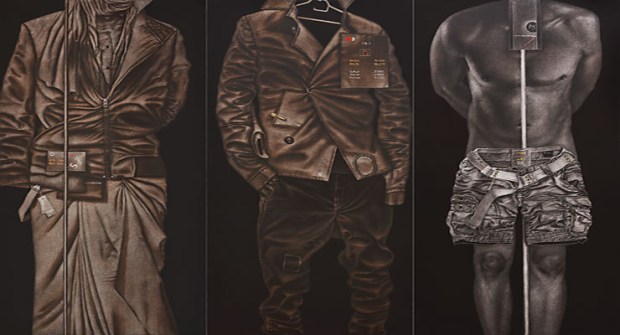A Glimpse Into Some Of The Biggest Art Exhibitions Of The Season
The eve of Diwali 2014 turned into a cultural fiesta with galleries and exhibition halls opening with glamorous art shows and visual events. A few of them took place in the artistic hub of South Delhi – Lado Sarai. October 19 saw the preview of Japanese artists at the Gallery Studio Art who, with their blooming plum trees and colourful outlines of mountain Fuji, seem to have brought with them the fragrance from the shores of the country of the Rising Sun.
Works in traditional and mixed media by T. Kataoka, N. Tamura, Y. Nojima evoked a special interest for their ability to interpret traditional motifs in modern context.
Another exhibition which cannot be missed is Zameen, which is curated by Ranjit Hoskote at Art District XIII and was opened in overcrowded halls under the inspiring presence of Kapil Chopra. Featuring a fine selection of emerging and established artists like Atul Dodiya, Ram Rahman, Veer Munshi, and Zarina Hashmi, the exhibition reveals different aspects of reality – matter known as the Earth. According to the curator, “The word that acts as the prompt for this exhibition project contains entire archives of sensation, intuition, memory, hope, loss and desire: zameen. While many of its subliminal reserves of meaning may resist translatability, this Urdu word can be parsed to occupy a range of connotations: earth, soil, territory, the boundary-marked ancestral land, the migratory cultural zone of belonging, the topographical or emotional guarantee of identity, genealogy or historical location.” These complexities of the concept of earth find their dramatic expression in the monumental digital work ‘Marking the Frame: the Secret History of Shape Shifters, What Belongs into Which Hand?’ by Ranbir Kaleka.
In his rather philosophical work, the artist is engaged in the process of the revelation of the Earth’s history and traces the evolutionary routes on the map of mankind where the Babylon towers rise and fall, and ruins of Buddhist monuments are mixed up with chimney factories of early industrialisation, where the fly of Sputnik outlines a new era and the expanding feeling of space. In the artist’s universe of imagery, the earth is being explored, discovered, studied and measured; metaphorical images and symbols of human presence overlap invisible migration routes of animals and birds; and real and unreal worlds seem to weave up a complex cosmogonist design pushing up objects from the canvas. The exhibition remains open till 2nd February 2015.
‘Manifestations XI: 75 Artists 20TH Century Indian Art’ is an annual show organised by the Delhi Art Gallery featuring works by renowned Indian artists from a period starting as early as the late 19th century with an unknown countryside painting by Raja Ravi Varma, lyrical paintings by G. Tagore, Asit Haldar and Prosanto Roy created between 1920-1930s, up to the present days with recognisable master strokes by K. Khanna, M. F. Hussain and H. Raza. The remarkable part of the Gallery’s activity is fundamental research and discovery of new lesser known or unknown masterpieces of Indian art – a substantial, illustrative volume with critical reviews and historical data was brought up for this occasion.
Indeed, the lovers of art exhibition are truly rewarded this festive season with the opening of yet another important show – a retrospective exhibition by Kala Vibhushan winning artist Rameshwar Broota presenting a collection of his works from 1963 till 2013. The exhibition titled ‘Visions of Interiority: Interrogating the Male Body’ curated by Roobina Karode was opened on 13 of October at Kiran Naddar Museum of Art – a magnetic centre of artistic, educational and cultural activities.
Thanks to the museum’s curator and its enthusiastic team, visitors have a rare opportunity to view paintings and art works of the artist selected from more than sixty public and private collections. Walking through the museum’s galleries, one cannot stop wondering about persistence of the artist and his engagement with the particular theme and the complexity of his mind process.
 In his latest series – where a gigantic male body seems undergoing continuous state of metamorphosis and finally transforms into a category, in a vibrant emotions, in memories and sufferings against the infinite landscape of the mind. As it is observed by the exhibition’s curator:
In his latest series – where a gigantic male body seems undergoing continuous state of metamorphosis and finally transforms into a category, in a vibrant emotions, in memories and sufferings against the infinite landscape of the mind. As it is observed by the exhibition’s curator:
“Broota’s engagement with the naked male body has been almost obsessive over the years. Magnified, monumentalised, mutated and measured, the observed body (mainly his own) has been put through microscopic lenses, x-rays, studied in detail, and as a macro cosmos with its palpable surface and bony structure, examined clinically by the artist. He has been a keen observer of its contours, its flexing anatomy that expands and contracts in order to change its form along with its use, its limits and ever growing potential. Yet, for Broota the (male) body remains a mystery; for it is more than a biologically programmed machine or a classically idealised form. Through his practice of self-introspection, the artist continues to investigate the interiority of the male body with unusual curiosity and depth.” The exhibition is on view till 30 December 2014.
Text : Vladimir Zaitsev
Bio : Vladimir Zaitsev is a curator, author and museologist affiliated with the National Museum, New Delhi.
For regular updates on art, art work, paintings & sketching, visit our social media pages by clicking the options below:


































